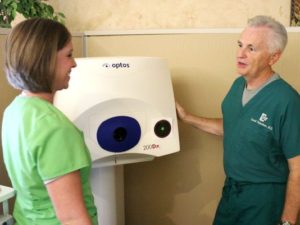“I told the company representative, there must be some mistake,” Richardson said. “This has to be the image of another patient — it can’t be mine.”
Jim Brennan with Optos, which provides the Optomap system, was demonstrating the new device to the clinic’s physicians and was using Richardson as a test subject. The image, which captured a wide panorama of the retina on the back wall of his eye, indicated an abnormality
“Viewing a patient’s retina primarily helps us diagnose vision problems, but it can also indicate problems elsewhere in the body,” Richardson said. “And that’s what I saw when I looked at the image of my eye — a possible blood vessel blockage somewhere else in my body.”
Brennan assured him the demonstration camera had never been used before and that his eye was the first one imaged by that particular unit. Alarmed, he called Dr. Robbie Robbins, a cardiovascular surgeon who set up a cardiac CT scan a couple days later on Friday. After undergoing the procedure, Richardson went home. A few hours later, Robbins called him.
“He asked me what I was doing,” Richardson recalled. “He then said, ‘Don’t do anything strenuous the rest of the weekend — I have a heart catheterization set up for you early next week.’ ”
The CT scan had revealed an occlusion of the left anterior descending artery of the heart, known commonly as the “widowmaker” artery. Heart attacks involving it are extremely dangerous and life-threatening.A few days after the surgery, he called Brennan with Optos. “I thanked him for bringing the camera that day. I believe God used that demonstration to save my life.”
The eye’s retina is a thin layer of cells that line the back of the eye and make up nearly 65 percent of the eye’s surface. It converts light into impulses and sends them to the optic nerve, which transmits them to the brain. Because of its extensive surface and network of blood vessels and nerve fibers, it’s an excellent indicator for potential vision problems such as macular degeneration, glaucoma or retinal detachment, all of which can lead to blindness. But it may also contain signs of other problems in the body such as increased blood pressure, diabetes and heart disease.
“We actually see quite a number of cases of general disease during our eye exams. I would estimate that we refer 10 to 20 percent of our patients to other physicians to check on abnormalities we’ve found,” Richardson said.
Go here if you’d like to know more about Optomap retinal imaging http://www.eye-contact.co.uk/retinal-imaging/.
Alternatively you can contact us http://www.eye-contact.co.uk/contact-us/

